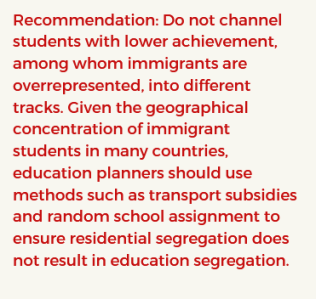On Tuesday, we launched the 2019 Global Education Monitoring (GEM) Report on migration and displacement. Looking at everyone on the move, different issues and challenges appear for different regions. Today will look at a key challenge for immigrants’ education in Europe, where they often end up segregated into different schools or into slower, often vocational, school tracks. This compounds their education disadvantages and exacerbates prejudices, creating a ‘them’ and ‘us’ reaction in host countries.
Two-thirds of migrants are destined for high-income countries, where they make up almost one in five students. But they are unequally spread between schools. In Berlin, for instance, one in five primary schools enrol twice as many students with migrant background than live in their catchment area. In 2017, in Italy, 17% of primary classrooms had more than 30% first-generation foreign-born students.
 In France, five times as many children of non-EU immigrants as children of French or EU parents attend lower secondary school in disadvantaged areas. In the Netherlands, some schools now have 80% immigrant students. We also found that non-native speakers in the United Kingdom were more likely to attend school with disadvantaged native speakers.
In France, five times as many children of non-EU immigrants as children of French or EU parents attend lower secondary school in disadvantaged areas. In the Netherlands, some schools now have 80% immigrant students. We also found that non-native speakers in the United Kingdom were more likely to attend school with disadvantaged native speakers.
This segregation is exacerbated by native students moving out of schools where there may be high concentration of immigrants to wealthier neighbourhoods, for instance in Denmark and the Netherlands. In the United States, for every four new non-English speakers in public secondary education, one native student switched to private school. As we covered in last year’s GEM Report, school choice is increasing inequalities; we found that it increased ethnic polarization of schools in Australia.
 We described some of the policies countries have trialed in order to address this segregation at the global launch event for the Report in Berlin yesterday. The francophone community in Belgium, for instance, tried a few years ago to introduce a lottery system for school assignment, which overruled the previous law that assigned schools by proximity. But this was also overturned with a weaker approach based on partnerships between schools. France tried to change its catchment area boundaries, but saw many children of middle-class parents switching their child to private schools as a result in cities like Marseille. Italy set a quota of no more than 30% of ‘foreign-born’ students in a class, but still almost 20% of classes exceeded the limit.
We described some of the policies countries have trialed in order to address this segregation at the global launch event for the Report in Berlin yesterday. The francophone community in Belgium, for instance, tried a few years ago to introduce a lottery system for school assignment, which overruled the previous law that assigned schools by proximity. But this was also overturned with a weaker approach based on partnerships between schools. France tried to change its catchment area boundaries, but saw many children of middle-class parents switching their child to private schools as a result in cities like Marseille. Italy set a quota of no more than 30% of ‘foreign-born’ students in a class, but still almost 20% of classes exceeded the limit.
If not separated by school, our report also found that many countries are separating low achievers into less demanding tracks. And, while vocational training can motivate disadvantaged students put off by more academic tracks, it may also compromise subsequent opportunities for students with immigrant backgrounds. Sorting by ability in this way also leads to inequality and a stronger association between social background and student results.
But such tracking starts as young as age 10 in Austria and Germany. In Germany, even after controlling for test scores in reading and mathematics, immigrants were seven percentage points more likely than their native peers to receive a recommendation for the lowest track.
We found the same issues in other countries too: Over five times as many students of Moroccan descent were in vocational training in the Netherlands, for example, in comparison to the Dutch. And this tracking particularly disadvantages male students with immigrant backgrounds.
 The reason why these issues matter of course, is that they affect migrants’ experiences, and opportunities in school. In the European Union, twice as many foreign-born youth as natives left school early in 2017. Learning outcomes are also far lower: In 2015, in Organisation for Economic Co-operation and Development countries, first-generation immigrants were 32% less likely and second-generation immigrants 15% less likely than natives to attain basic proficiency in reading, mathematics and science.
The reason why these issues matter of course, is that they affect migrants’ experiences, and opportunities in school. In the European Union, twice as many foreign-born youth as natives left school early in 2017. Learning outcomes are also far lower: In 2015, in Organisation for Economic Co-operation and Development countries, first-generation immigrants were 32% less likely and second-generation immigrants 15% less likely than natives to attain basic proficiency in reading, mathematics and science.
These cases brought to light the need to spend proper time examining education systems to fully understand the different degrees of inclusion of migrants in schools. They showed that immigrants may be nominally included, but practically excluded from education, and where work remained to be done.




